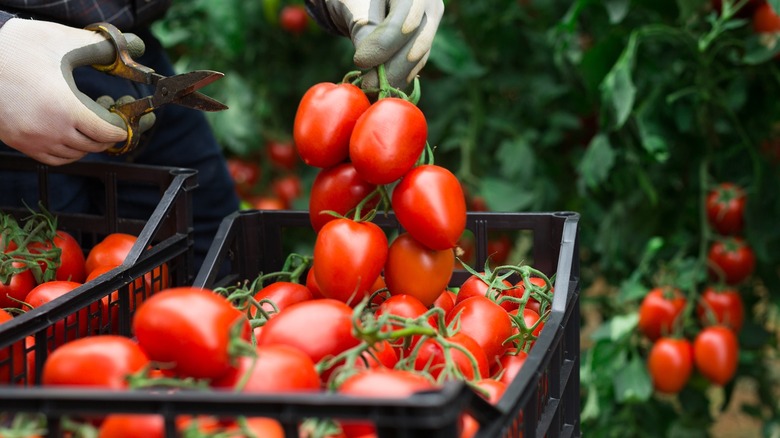Why Tomato Wine Looks Nothing Like You Would Expect
Grapes may be the go-to ingredient used in winemaking, but that doesn't mean they're the only option. The reality is that wonderfully complex wines can be crafted with anything from earthy avocados to heirloom tomatoes. Albeit unconventional, the latter can produce a wine that teems with an abundance of nuanced aromas and flavors, rivaling that of a conventional wine. Yet, far from the fire engine red hue that might be expected, tomato wine has a more subtle coloring. The question we're asking is, why?
Making tomato wine entails a nearly identical vinification process to traditional winemaking. Similar to grapes, tomatoes are crushed and fermented with yeast all before being bottled. However, given that tomatoes and grapes are two uniquely different types of produce, it only makes sense that they would behave differently when vinified. That said, despite their deeply crimson hue, color can't be easily extracted from tomatoes during winemaking due to the composition of their skins.
Unlike grape skins, tomato skins lack necessary levels of tannins. Since tannins are what give a wine its hue, tannin-weak tomatoes won't impart much color, regardless of how long they're macerated in the juice. As a result, tomato wine will always appear less pigmented, similar to a golden-hued white wine. Another role of tannins is to increase flavor and texture, but that doesn't mean a tomato wine void of these polyphenolic compounds lacks depth. In fact, quite the contrary is true.
Everything you need to know about tomato wine
Tomato wine has been gaining traction since Pascale Miche unveiled Omerto, the world's first commercial aperitif tomato wine. As a way of honoring his grandfather's wartime recipe of vin de tomate and putting his extra garden produce to good use, the specialty wine was born. Though the type of tomatoes used and the winemaking techniques employed shape the final product, tomato wine often boasts many of the gustatory characteristics that you might expect. Offering a crisp acidity and borderline herbaceous quality that recalls sauvignon blanc, tomato wine is vegetal and zesty. It's also fruity and floral with notes of citrus and traces of orange blossom.
When it comes to enjoying the wine, it's best served slightly chilled in order to elevate aromas and highlight its acidity. While drier styles are perfect alongside sushi, oak-aged tomato wines are great with charcuterie, and sweeter renditions are the ideal companion for sharp cheeses and decadent desserts. Alternatively, tomato wine can be used as the base in cocktails like a Caesar, or to transform anything from a basic pan sauce to a custardy zabaglione.
Looking to buy tomato wine? Tracking down a bottle may require some effort, but it isn't impossible. To streamline the search, we recommend seeking out specialty grocers or online retailers. Otherwise, you could feed your home brewing habit by using your own garden bounty to make tomato wine. Whatever you decide, a taste of tomato wine will make all your efforts worthwhile!

